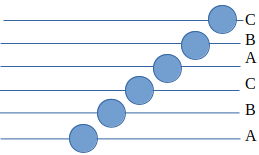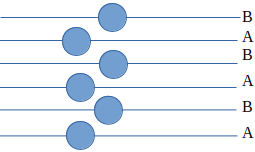This set of Mechanical Metallurgy Multiple Choice Questions & Answers (MCQs) focuses on “Plastic Deformation of Single Crystal – Stacking Fault”.
1. Tin cry phenomena is associated with ______________
a) twin
b) slip
c) annealing
d) oxidation
View Answer
Explanation: Twins can form in very short time of few microseconds, while slip takes time in order of several milliseconds before a slip band is formed. Under certain conditions, the formation of twins is audiable as a click or loud report known as the tin cry.
2. Twinning is not associated with specific crystallographic direction; it only depends on the direction of mechanical force. There is no preferred orientation of twinning in crystal.
a) True
b) False
View Answer
Explanation: Twinning occurs in a definite direction on a specific crystallographic plane for each crystal structure.
3. There are three metals given below.
Metal A – Very few numbers of the slip systems
Metal B – High critical resolved shear stress
Metal C – High number of the slip system
Which of the following is more susceptible for twining?
a) Metal A
b) Metal A and Metal B
c) Metal A and Metal C
d) Metal C
View Answer
Explanation: Twinning is not a dominant deformation mechanism in metals which possess many possible slip systems. Twinning generally occurs when the slip systems are restricted or when something increases the critical resolved shear stress so that the twinning stress is lower than the stress for the slip.
4. Which of the following is not matching correctly?
Metal ————> Twin Plane ———> Twin Direction
a) alpha iron ——> (112) ————–>[111]
b) Silver ———-> (111) ————–>[112]
c) Copper ———-> (111) ————–>[112]
d) Zinc ————> (112) ————–>[111]
View Answer
Explanation:
| System | Twin plane | Twin Direction |
|---|---|---|
| BCC | (112) | [111] |
| FCC | (111) | [112] |
| HCP |
Alpha iron –> BCC
Silver and Copper ——> FCC
Zinc ——-> HCP
So, Zinc is not matching.
5. The stacking sequence of the atomic arrangement for FCC is ___________
a) ABCABCABC
b) ABABABABA
c) AABBAABBAA
d) AAAAAAAAA
View Answer
Explanation: The sequence of stacking in FCC is like layer A then Layer B then layer C;
Following diagram show the pattern of stacking-

6. The stacking sequence of the atomic arrangement for HCP is ___________
a) ABCABCABC
b) ABABABABA
c) AABBAABBAA
d) AAAAAAAAA
View Answer
Explanation: The sequence of stacking in HCP is like layer A then Layer B then layer A;
Following diagram show the pattern of stacking-

7. The stacking fault in FCC will create a thin region of ___________ in stacking of the FCC.
a) HCP
b) BCC
c) SC
d) DC
View Answer
Explanation: The stacking sequence of the FCC is ABCABCABC. But the introduction of stacking fault in FCC causes shift of plane from ABC|BCABC, here plane A is missing. So the region will become BCBC, this is equivalent to HCP stacking sequence.
8. Which of the following represents the extrinsic stacking fault in the FCC Metal?
a) ABCABCABC
b) ABCBCABC
c) ABCACBCABC
d) ABABABABA
View Answer
Explanation: The extrinsic stacking fault is equivalent of inserting extra plane in the stacking sequence of FCC. In ABCA|C|BCABC, the plane C is extra, and it creates the twin region around the fault and also called twin stacking fault.
9. The _______ the stacking-fault energy, the higher the separation between the partial dislocations and the ________ the stacking fault.
a) lower, wider
b) higher, wider
c) lower, narrow
d) higher, narrow
View Answer
Explanation: The lower the stacking-fault energy, the higher the separation between the partial dislocations and the wider the stacking fault. The stacking fault energy is among the essential concept of mechanical metallurgy.
10. Metals with wide stacking faults (low SFE) strain-harden more rapidly, twin easily on annealing, and shows a different temperature dependence of flow stress than metals with narrow stacking faults.
a) True
b) False
View Answer
Explanation: The statement is true and very important. Metals with high SFE have a deformation substructure of dislocation tangles and cells, while low-SFE metals show deformation substructure of banded, linear arrays of dislocations.
Sanfoundry Global Education & Learning Series – Mechanical Metallurgy.
To practice all areas of Mechanical Metallurgy, here is complete set of 1000+ Multiple Choice Questions and Answers.
If you find a mistake in question / option / answer, kindly take a screenshot and email to [email protected]
- Check Metallurgical Engineering Books
- Check Mechanical Metallurgy Books
- Practice Metallurgical Engineering MCQs
- Apply for Metallurgical Engineering Internship
